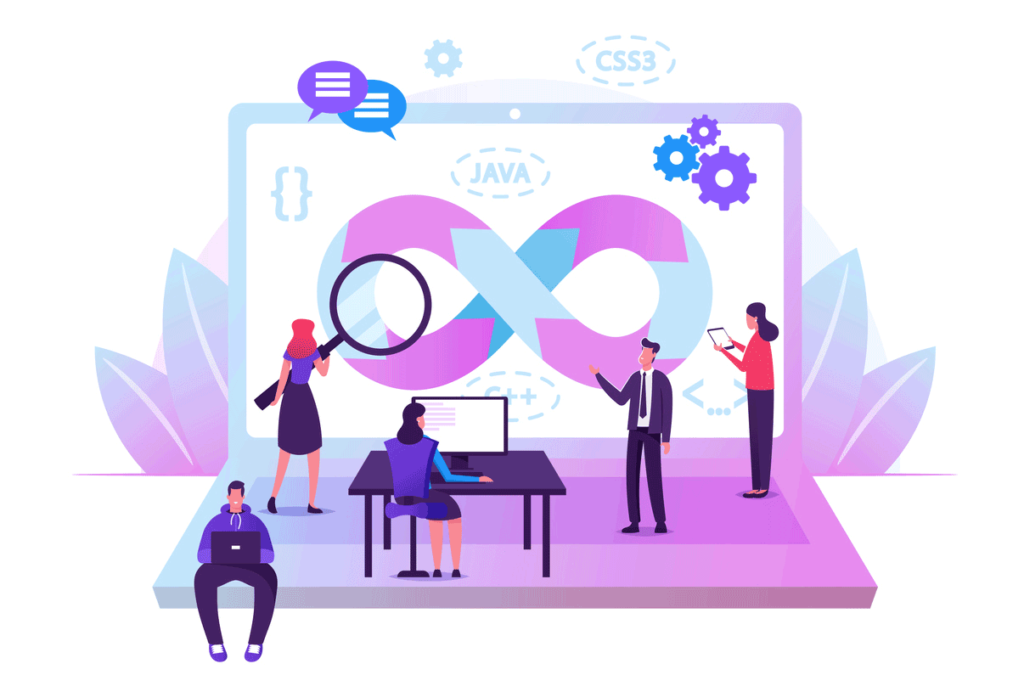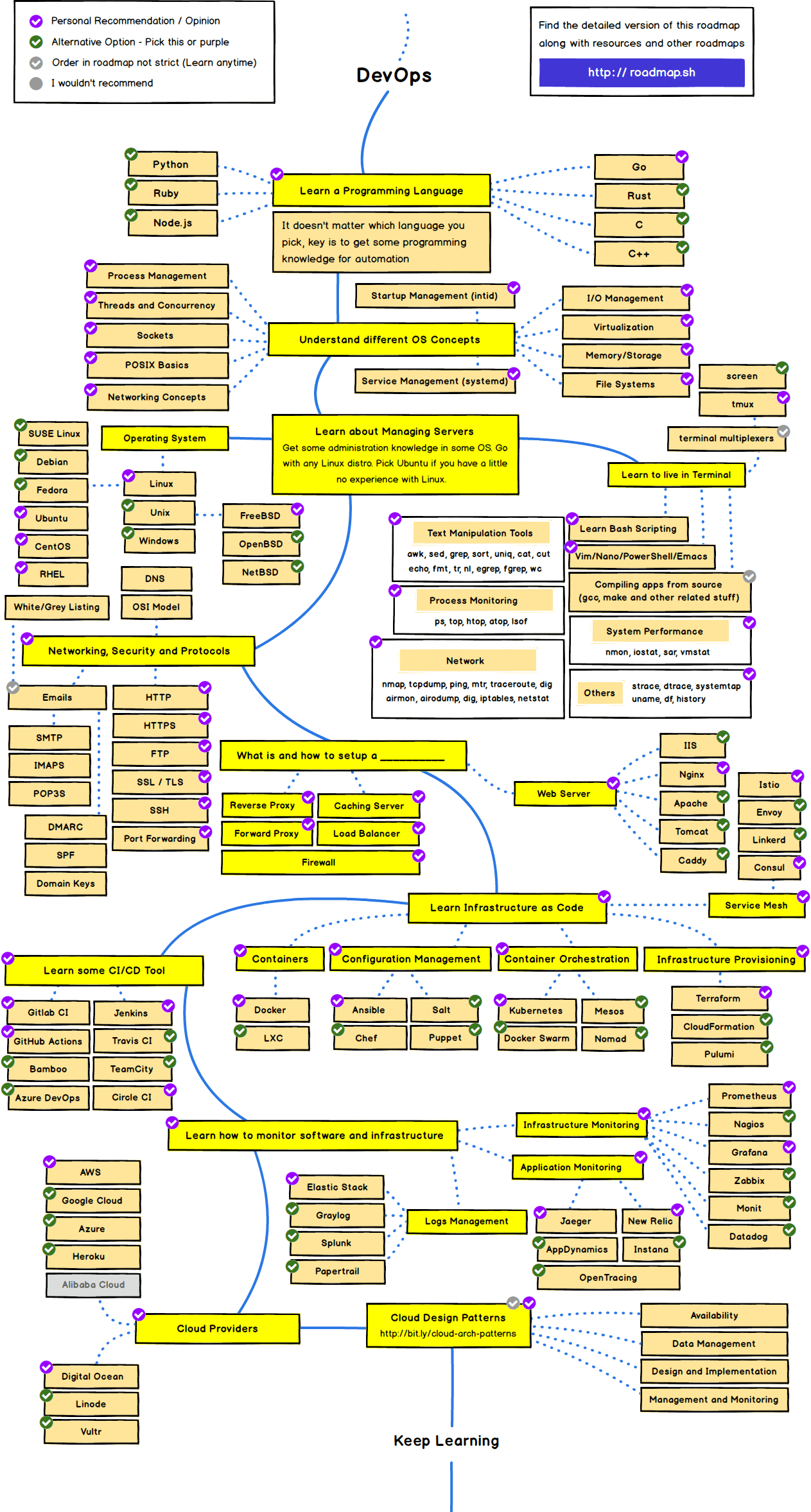The DevOps RoadMap for Developers

DevOps roadmap is the adoption of DevOps culture and it’s about technologies and tools and an ongoing practice to build and maintain scalable web applications. DevOps culture when properly implemented can bring many advantages, like faster time to market, fewer mistakes and errors costs, efficiency in cost, early errors detection, speedy automation, a better connection with the team, an excellent feedback loop, and the adoption of different DevOps tools, etc. However, DevOps isn’t easy to master, and given the numerous techniques and tools, it can be difficult for a DevOps engineer to determine the right path.
DevOps roadmap is a long-term plan that requires time and effort. Adopting a DevOps strategy throughout every stage of the software lifecycle. Start from Plan, Build, Code, Test, Release, Deploy, Operate to Monitor. DevOps removes a lot of bottlenecks that the traditional SDLC had created, and it has also brought significant changes to the system.
In this post, I’ll walk you through the most popular DevOps roadmap that you can use as a reference to become an exceptional DevOps engineer.

Take a look at the DevOps RoadMap step-by-step and learn how to master the necessary skills to be a DevOps master.
1. Programming Language
To become a DevOps Engineer, your initial step is to study the programming language because it is beneficial to integrate databases, debugging codes or automate the process of development and deployment.
2. Operating System
Operating systems are a program that controls the operation of an application and serves to act as an interfacing device between the user and the computer hardware. It’s concerned with distributing resources and services like memory, processors, and appliances. As a DevOps engineer, it’s imperative to be aware of operating systems because servers will need to run the software. Linux is the preferred OS since businesses and servers widely use it for running their web-based applications. But, you may select different operating systems, such as:
3. Operating System Concepts
Understanding the various concepts in operating systems is essential for DevOps engineers, as you’ll be in charge of creating the infrastructure needed for running an application. Some of the terms that you should know include:
- Process Management
- Startup Management
- Threads & Concurrency
- Sockets
- POSIX Basics
- I/O Management
- Virtualization
- Memory/Storage
- File Systems
- Service Management
- Networking Concepts
4. Live In Terminals
As a DevOps engineer having command of the terminal (especially working on Linux and Unix) is vital. Terminal, also referred to by the name console or commands, can help developers automate and complete tasks without the GUI (graphical user interface). It is essential to know the commands to:
- Text Manipulation
- Bash Scripting
- Process Monitoring
- System Performance
- Network
- Compiling Apps From Source
- Vim/Nano/Emacs/Powershell
5. Networking Security & Protocols
Security and protocols for networks aid in ensuring the security and integrity of data as it moves through networks. It defines the procedures and methods to safeguard the network from any attempts to obtain or access data. A few of the protocols for the security of networks that you must be aware of include:
- HTTPS
- HTTP
- FTP
- SSL/TLS
- SSH
- Port Forwarding
- IPSec & VPNs
- AT-TLS
- OSPF Authentication
- SNMP
- Firewall
- Proxy Services
6. Web Server
A web server can store information like video, text images, application information or text on a website and provides users with it on request. A web server may host several websites simultaneously, using similar hardware. It connects to the browser on the internet using HTTP/HTTPS. By understanding its operation and functionality, a DevOps engineer can easily manage and observe the server.
Some of the features of the Web Server that you can discover are:
7. Infrastructure as Code
Infrastructure as Code or IaC is the main component of DevOps. It aids in the managing and provisioning of infrastructure (networks load balancers, network infrastructure and connection topology) by using codes or configuration files instead of manual procedures. It makes the deployment process more automated and straightforward as you can create the environment according to the specifications.
A few of the terms as well as tools from IaC that you can comprehend are:
Containers
Configuration Management
Container Orchestration
Service Mesh
Infrastructure Provisioning
- Terraform
- CloudFormation
- Pulumi
- CI/CD Tools
Continuous Integration and Continuous Deployment (CI/CD) involves operating principles and practices that enable developers to offer more frequent and reliable updates. Continuous integration focuses on code integration done by developers within the repository’s principal branch. Continuous development also allows the automatic release of approved code to the repo. The tools one can utilize for CI/CD are:
Read more: Top 30 Most Effective DevOps Tools for 2022
8. Infrastructure Monitoring
Monitoring your infrastructure involves capturing information about your infrastructure to help you make operational decisions. It uses the data generated by servers, apps networks, and other components to monitor the performance of your networks, such as throughput, hardware capacity, and uptime. The data gathered through infrastructure monitoring can help improve effectiveness, reduce errors, and provide improvement areas. Infrastructure monitoring tools include:
9. Application Monitoring
Application monitoring is assessing the performance, user experience and availability of an application. The information gathered through monitoring can be used to find and correct issues with the application before they affect users. Monitoring software for applications includes:
10. Logs Management
A log is the complete record of all events within the system. A DevOps engineer can analyze log events to identify security issues, improve services, and issue alerts to identify bottlenecks. The tools that are used to manage logs include:
- Elastic Stack
- Splunk
- Papertail
- Graylog
11. Cloud Design Pattern
Cloud design patterns can create high-performance, secure, and reliable applications for the cloud. Each pattern outlines the issue identified and the method of applying the pattern. A few of these cloud designs are like this:
- CQRS
- Event Sourcing
- Ambassador
- Anti-corruption Layer
- Compute Resource Consolidation
- External Config Store
- Gateway Aggregation
- Gateway Offloading
- Gateway Routing
- Pipes and Filters
- Sidecar
12. Cloud Providers & Packages
As a DevOps engineer, you must be aware of cloud computing technology and its advantages and the requirements, services, providers, and plans for your business. The top-rated and most frequently used cloud services companies are:
Be aware that the plans that these companies offer may differ according to the number of domains and the memory, CPU and SSL Certificates that are required.
13. Other Technologies
Alongside the mentioned tools, techniques, and technology, there are several other things you should be aware of. This list contains:
Read more: Top 10 DevOps Trends to Watch 2022
Keep in mind that this article is meant to help you determine the direction and determine which skills you’ll need in the coming months. There will always be changes to the tools and technologies that are part of the DevOps strategy in the near future. Therefore, don’t be comfortable with your job and constantly seek out information about recent developments and technologies, and it will help ensure your professional growth.
